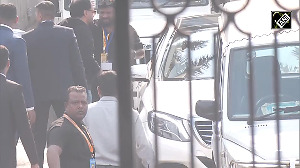Six months after 21 states introduced the value-added tax, it would be safe to say that the experiment has been a success. Certainly, the worst case scenario, in which revenues would actually decline, did not materialise.
Revenues have increased in all the states that made the transition. For proponents of VAT, the more meaningful question is whether the new system has induced acceleration in revenue growth even in so short a time period. The evidence generally suggests that this is indeed the case.
Revenue collections between April and August 2005, aggregated across all the states, which introduced VAT, grew by about 15.7 per cent from the corresponding period last year.
In the five-year period before the introduction of VAT, the annual growth rate of tax revenues from comparable taxes was around 12.3 per cent. Of course, the performance of the industrial sector has a lot to do with indirect tax buoyancy, but let's keep in mind the fact that the industrial sector has been doing reasonably well since 2002-3.
Its performance alone cannot explain the acceleration during the first few months of this year.
The acceleration is not uniform across states. Between April and September 2005, Punjab, Delhi, and Orissa appear to have gained the most, with revenue growing by 39, 30, and 29 per cent, respectively.
Revenues in Karnataka grew by about 22 per cent. West Bengal and Maharashtra saw revenues increase by about 10.8 and 9.3 per cent, respectively (although the latter's growth rate reflects a 7 per cent fall during September).
Kerala saw a growth rate of a mere 3.8 per cent. To a significant extent, the lower growth rates appear to be the result of the harmonisation of tax rates across states; some states had to lower the rates applicable to a large number of commodities.
Notwithstanding these relatively reassuring numbers, several states have sought compensation for revenue "losses", which was promised by the Centre. Rs 5,100 crore (Rs 51 billion) was provided for compensation during the current fiscal year.
For the first quarter, about Rs 688 crore (Rs 6.88 billion) was paid out. If this is a representative number, the total payout will be significantly below the amount provided.
However, it must be emphasised that a demand for compensation does not necessarily mean that the state has been doing badly on revenue collection.
The benchmark used to assess losses is the average collection in the best three out of the last five years. States, which had a particularly good year or two can claim compensation even when VAT revenues have been healthy.
Many factors that may have played a role in this relatively positive outcome are yet to be understood. They will be undoubtedly analysed in the days to come and we will have a far clearer view about the sustainability of the initial performance. Pending that, here is a possible explanation for the early patterns.
Consider a producer who is already in the net and paying taxes. He has the choice of procuring an input from two providers, one who is in the net and another who isn't.
In the pre-VAT regime, assuming that the costs of production of both suppliers were identical, the second one would be able to undercut the first on his selling price to the extent of the tax.
In the VAT regime, the buyer has to trade off the price advantage that the second producer offers with the offset he could claim were he to trade with the first supplier. Clearly, the price advantage offered by the second provider would have weakened. Whether or not it is completely eliminated depends largely on the difference between the old and new tax rates.
The point is that, now, producers who pay taxes have a very strong incentive to deal only with suppliers who also do so. This should induce at least some producers to register themselves rather than risk going out of business.
Once they do so, they also face exactly the same incentives. This is essentially the principle of network expansion; as a network grows, it becomes more and more attractive for outsiders to join it.
If this explanation is valid, it implies a huge boost to state revenues in the medium term, as economic activity that took place outside the tax net comes into it. There are at least three implications for immediate action by both state and the central governments.
First, states that have not implemented VAT should do so as quickly as possible. There are indications that this might happen, but given the clear political divide between the VATs and the VAT-nots, pragmatic considerations of revenue buoyancy may still be dominated by short-term political manoeuvering. Chief ministers of non-compliant states should realise the price they are paying for the delay.
Second, the current system provides for tax credits for intra-state transactions only. The roadmap clearly calls for scaling this up so that inter-state transactions are also eligible for credits.
Until this happens, inefficiencies of a "trade diverting" nature will show up. Producers may have an incentive to buy their inputs from suppliers within the state because of the credits, rather than from more efficient suppliers who are located outside the state.
This will particularly hurt states whose economies depend heavily on a few critical sectors, whose product is mainly sold outside the state.
Speeding up the implementation of a national system of tax should be a priority. Even if all the states have not complied, it is worth doing this. Its implementation will put even greater pressure on states to comply because, if they don't, they risk getting shut out of an expanding common market.
Third, VAT may well prove to be the most effective way of inducing establishments to enter the tax net. However, for most of them, it is not the only tax they should be paying. Their entry into the VAT database should immediately bring them into the several other taxpayer databases that central, state and local governments use, but currently operate in blissful ignorance of each other.
Unifying and integrating tax databases should be child's play, given our IT capabilities, but it will need both appreciation and co-operation from various levels of government, a far more difficult objective!
Properly leveraged and exploited, VAT is potentially the solution to the economy's inability to significantly increase its tax-GDP ratio without significantly disrupting economic activity. Its greatest strength is that it makes paying taxes essential to business survival. Virtue is, indeed, necessity.
The author is chief economist, Crisil. The views here are personal




